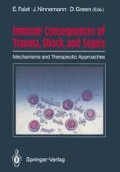Abstract
Immunosuppression in trauma patients has been well documented by several groups. The causes of this suppression are at both the humoral and cellular level. Many of the described immunosuppressive effects can be induced in normal cells by coincubation with trauma serum, suggesting the presence of circulating immunosuppressive factors. The isolation and partial characterization of a low molecular weight peptide from the serum of trauma patients have been previously described [1].
Access this chapter
Tax calculation will be finalised at checkout
Purchases are for personal use only
Preview
Unable to display preview. Download preview PDF.
References
Ozkan AN, Ninnemann JL (1985) Suppression of an in vitro lymphocyte and neutrophil responses by a low molecular weight depressive active peptide from burn patient sera. J Clin Immunol 5: 172
Hoyt DB, Ozkan AN, Ninnemann JL et al. (1988) Trauma peptide induction of lymphocyte changes predictive of sepsis. J Surg Res 45: 342–348
Ozkan AN, Pinney E, Hoyt DB et al. (1983) Elastase and suppressor active peptide activity following injury. J Trauma 28: 207–210
Ozkan AN, Hoyt DB, Tompkins S et al. (1988) Immunosuppressive effects of a trauma induced suppressor active peptide. J Trauma 28: 589–592
Ozkan An, Hoyt DB, Ninnemann JL et al. (1988) Trauma peptide mediated prostaglandin E2 biosynthesis: a potential mechanism for trauma induced immunosuppression. Immunol Lett 17: 79
Rodrick ML, Wood JJ, O’Mahony JB et al. (1986) Mechanisms of immunosuppression associated with severe nonthermal traumatic injuries in man: production of interleukin 1 and 2. J Clin Immunol 6: 310
Teodorczyk-Injeyan JA, Sparkes BG, Mills GB et al. (1987) Impaired expression of in- terleukin-2 receptor (IL2R) in the immunosuppressed burned patient: reversal by exogenous IL2. J Trauma 27: 180
Editor information
Editors and Affiliations
Rights and permissions
Copyright information
© 1989 Springer-Verlag, Berlin Heidelberg
About this paper
Cite this paper
Hoyt, D.B., Pinney, E., Ozkan, A.N. (1989). Trauma Peptide T-Cell Suppression: Mechanisms of Action. In: Faist, E., Ninnemann, J.L., Green, D.R. (eds) Immune Consequences of Trauma, Shock, and Sepsis. Springer, Berlin, Heidelberg. https://doi.org/10.1007/978-3-642-73468-7_37
Download citation
DOI: https://doi.org/10.1007/978-3-642-73468-7_37
Publisher Name: Springer, Berlin, Heidelberg
Print ISBN: 978-3-642-73470-0
Online ISBN: 978-3-642-73468-7
eBook Packages: Springer Book Archive

